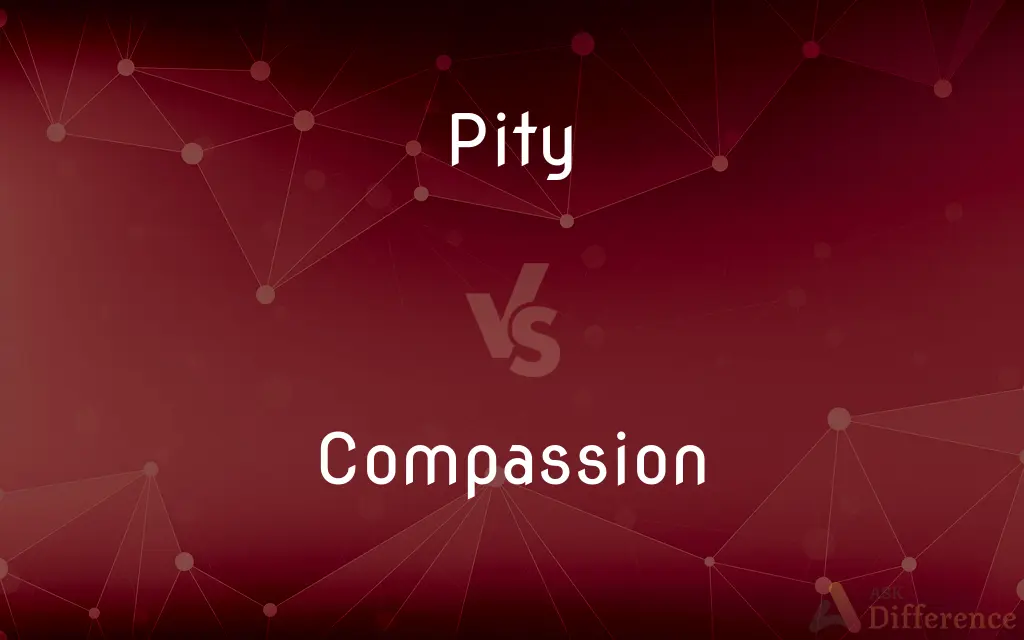Pity vs. Compassion — What's the Difference?
By Fiza Rafique & Urooj Arif — Updated on March 21, 2024
Pity involves feeling sorrow for someone's misfortune, often with a sense of distance, while compassion involves empathy and a desire to help alleviate suffering.

Difference Between Pity and Compassion
Table of Contents
ADVERTISEMENT
Key Differences
Pity is an emotional response characterized by feelings of sorrow or sympathy for the misfortunes or sufferings of others. It often contains an element of condescension, where the one feeling pity may view themselves as superior or detached from the person they pity. On the other hand, compassion is a deeper, more empathetic connection to another's pain or suffering, accompanied by a genuine desire to help or alleviate that suffering.
While pity can sometimes be passive or superficial, merely acknowledging someone's hardship without a deep emotional engagement or a drive to assist, compassion motivates action and involves a sense of shared humanity. Compassion leads to an understanding and caring approach that seeks to positively impact the lives of those who are suffering.
Pity might sometimes reinforce the separation between individuals, highlighting the differences in circumstances without fostering a true sense of connection or shared experience. In contrast, compassion diminishes these barriers, promoting a sense of unity and commonality in human experience, and often results in supportive actions.
The concept of pity can sometimes carry negative connotations, suggesting a lack of respect for the dignity or agency of the person in suffering. Compassion, however, is seen as a virtuous quality, indicative of emotional maturity and a deep sense of kindness and humanity.
Understanding the difference between pity and compassion is crucial in various aspects of life, including personal relationships, professional caregiving, and social justice efforts. While pity might recognize suffering, compassion takes it a step further by actively seeking to understand, empathize, and mitigate that suffering.
ADVERTISEMENT
Comparison Chart
Emotional Response
Feelings of sorrow for someone's misfortune.
Empathetic connection to another's suffering.
Perspective
May involve a sense of superiority or distance.
Involves a sense of shared humanity.
Action
Often passive, without a drive to assist.
Motivates a desire to help or alleviate suffering.
Connection
Can reinforce separation between individuals.
Promotes unity and understanding.
Connotations
Sometimes viewed negatively or as superficial.
Seen as virtuous, showing deep kindness.
Compare with Definitions
Pity
Feeling sorrow for the misfortunes of others.
She felt a wave of pity for the lost and hungry animals.
Compassion
Deep empathy for someone's suffering, with a desire to help.
Moved by compassion, she volunteered to aid disaster victims.
Pity
Can be seen as looking down from a position of relative advantage.
His look of pity made her feel even more helpless.
Compassion
Involves recognizing shared experiences and common humanity.
His compassion was evident, treating everyone's pain as if it were his own.
Pity
Can maintain emotional distance and sometimes unintentional condescension.
The community's pity felt hollow to those who needed real support.
Compassion
Includes a strong emotional investment and connection.
Compassion drove her to spend hours comforting her grieving friend.
Pity
Often limited, without a personal emotional connection.
Many expressed pity for the victims but did little to help.
Compassion
Often leads to practical efforts to support or assist those in need.
Their compassion translated into a community-wide relief effort.
Pity
Rarely accompanied by efforts to alleviate the suffering.
Pity by itself did not change the dire situation they were in.
Compassion
Builds bridges of understanding and fosters mutual respect.
The compassion shown by strangers restored her faith in humanity.
Pity
Pity is a sympathetic sorrow evoked by the suffering of others, and is used in a comparable sense to compassion, condolence or empathy - the word deriving from the Latin pietās (etymon also of piety). Self-pity is pity directed towards oneself.
Compassion
Compassion motivates people to go out of their way to help the physical, mental, or emotional pains of another and themselves. Compassion is often regarded as having sensitivity, which is an emotional aspect to suffering.
Pity
Sympathy and sorrow aroused by the misfortune or suffering of another.
Compassion
Sympathetic pity and concern for the sufferings or misfortunes of others
The victims should be treated with compassion
Pity
A matter of regret
It's a pity she can't attend the reception.
Compassion
Deep awareness of the suffering of another accompanied by the wish to relieve it.
Pity
To feel pity for or on account of
"No, he could not believe it a bad house.
Not such a house as a man was to be pitied for having" (Jane Austen). "An office worker pitied his confinement and slipped in to give him a loaf of bread" (Eric Scigliano).
Compassion
Deep awareness of the suffering of another, coupled with the wish to relieve it.
Pity
To feel pity.
Compassion
(obsolete) To pity.
Pity
(uncountable) A feeling of sympathy at the misfortune or suffering of someone or something.
I can't feel any pity towards the gang, who got injured while attempting to break into a flat.
Take pity on someone
Compassion
Literally, suffering with another; a sensation of sorrow excited by the distress or misfortunes of another; pity; commiseration.
Womanly ingenuity set to work by womanly compassion.
Pity
(countable) Something regrettable.
It's a pity you're feeling unwell because there's a party on tonight.
What a pity about the band breaking up. I loved them!
Compassion
To pity.
Pity
(obsolete) Piety.
Compassion
A deep awareness of and sympathy for another's suffering
Pity
(transitive) To feel pity for (someone or something).
You have got to pity the guy - he lost his wife, mother and job in the same month.
Compassion
The humane quality of understanding the suffering of others and wanting to do something about it
Pity
To make (someone) feel pity; to provoke the sympathy or compassion of.
Pity
Short form of what a pity.
Pity
Piety.
Pity
A feeling for the sufferings or distresses of another or others; sympathy with the grief or misery of another; compassion; fellow-feeling; commiseration.
He that hath pity upon the poor lendeth unto the Lord.
He . . . has no more pity in him than a dog.
Pity
A reason or cause of pity, grief, or regret; a thing to be regretted.
What pity is itThat we can die but once to serve our country!
Pity
To feel pity or compassion for; to have sympathy with; to compassionate; to commiserate; to have tender feelings toward (any one), awakened by a knowledge of suffering.
Like as a father pitieth his children, so the Lord pitieth them that fear him.
Pity
To move to pity; - used impersonally.
It pitieth them to see her in the dust.
Pity
To be compassionate; to show pity.
I will not pity, nor spare, nor have mercy.
Pity
A feeling of sympathy and sorrow for the misfortunes of others;
The blind are too often objects of pity
Pity
An unfortunate development;
It's a pity he couldn't do it
Pity
The humane quality of understanding the suffering of others and wanting to do something about it
Pity
Share the suffering of
Common Curiosities
How can one transform pity into compassion?
Transforming pity into compassion involves deepening one's understanding and emotional connection to the suffering of others and moving towards actionable support.
Can societal attitudes influence whether an emotion is perceived as pity or compassion?
Yes, cultural and societal norms can shape how emotions are interpreted, with some contexts more likely to value the active, engaged nature of compassion.
Is pity always a negative feeling?
While not inherently negative, pity can sometimes be perceived as condescending or superficial because it may lack a deeper, empathetic engagement.
Why is compassion preferred over pity in caregiving professions?
In caregiving, compassion is preferred because it fosters a more respectful, empathetic, and supportive relationship between caregivers and those they care for.
Can someone feel both pity and compassion?
Yes, it's possible to experience a blend of both emotions, but compassion is generally considered a more mature and constructive response.
How can one cultivate more compassion in their life?
Cultivating compassion can involve mindfulness practices, actively seeking to understand others' perspectives, and engaging in acts of kindness and support.
How do children learn the difference between pity and compassion?
Children learn through observation, guidance from adults, and their own experiences of empathy and kindness, which help them understand the nuanced differences.
What role does empathy play in compassion that might be absent in pity?
Empathy, involving the ability to deeply understand and share the feelings of another, is central to compassion but may be less intense or absent in pity.
How do actions differ between pity and compassion in a social justice context?
In social justice, pity might lead to token gestures of support, while compassion drives sustained, meaningful efforts to address systemic issues and support empowerment.
Does compassion always require action, or can it be a standalone emotion?
While compassion often motivates action, it can also exist as a profound, standalone emotional response, reflecting deep empathy and concern.
Share Your Discovery

Previous Comparison
Newsreader vs. Newscaster
Next Comparison
Homozygous vs. HemizygousAuthor Spotlight
Written by
Fiza RafiqueFiza Rafique is a skilled content writer at AskDifference.com, where she meticulously refines and enhances written pieces. Drawing from her vast editorial expertise, Fiza ensures clarity, accuracy, and precision in every article. Passionate about language, she continually seeks to elevate the quality of content for readers worldwide.
Co-written by
Urooj ArifUrooj is a skilled content writer at Ask Difference, known for her exceptional ability to simplify complex topics into engaging and informative content. With a passion for research and a flair for clear, concise writing, she consistently delivers articles that resonate with our diverse audience.















































